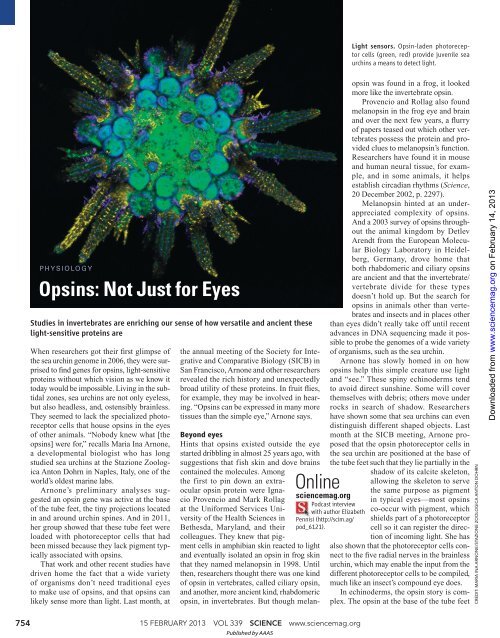et al.
et al.
et al.
You also want an ePaper? Increase the reach of your titles
YUMPU automatically turns print PDFs into web optimized ePapers that Google loves.
754<br />
PHYSIOLOGY<br />
Opsins: Not Just for Eyes<br />
Studies in invertebrates are enriching our sense of how versatile and ancient these<br />
light-sensitive proteins are<br />
When researchers got their fi rst glimpse of<br />
the sea urchin genome in 2006, they were surprised<br />
to fi nd genes for opsins, light-sensitive<br />
proteins without which vision as we know it<br />
today would be impossible. Living in the subtid<strong>al</strong><br />
zones, sea urchins are not only eyeless,<br />
but <strong>al</strong>so headless, and, ostensibly brainless.<br />
They seemed to lack the speci<strong>al</strong>ized photoreceptor<br />
cells that house opsins in the eyes<br />
of other anim<strong>al</strong>s. “Nobody knew what [the<br />
opsins] were for,” rec<strong>al</strong>ls Maria Ina Arnone,<br />
a development<strong>al</strong> biologist who has long<br />
studied sea urchins at the Stazione Zoologica<br />
Anton Dohrn in Naples, It<strong>al</strong>y, one of the<br />
world’s oldest marine labs.<br />
Arnone’s preliminary an<strong>al</strong>yses suggested<br />
an opsin gene was active at the base<br />
of the tube fe<strong>et</strong>, the tiny projections located<br />
in and around urchin spines. And in 2011,<br />
her group showed that these tube fe<strong>et</strong> were<br />
loaded with photoreceptor cells that had<br />
been missed because they lack pigment typic<strong>al</strong>ly<br />
associated with opsins.<br />
That work and other recent studies have<br />
driven home the fact that a wide vari<strong>et</strong>y<br />
of organisms don’t need tradition<strong>al</strong> eyes<br />
to make use of opsins, and that opsins can<br />
likely sense more than light. Last month, at<br />
the annu<strong>al</strong> me<strong>et</strong>ing of the Soci<strong>et</strong>y for Integrative<br />
and Comparative Biology (SICB) in<br />
San Francisco, Arnone and other researchers<br />
reve<strong>al</strong>ed the rich history and unexpectedly<br />
broad utility of these proteins. In fruit fl ies,<br />
for example, they may be involved in hearing.<br />
“Opsins can be expressed in many more<br />
tissues than the simple eye,” Arnone says.<br />
Beyond eyes<br />
Hints that opsins existed outside the eye<br />
started dribbling in <strong>al</strong>most 25 years ago, with<br />
suggestions that fish skin and dove brains<br />
contained the molecules. Among<br />
the first to pin down an extraocular<br />
opsin protein were Ignacio<br />
Provencio and Mark Rollag<br />
at the Uniformed Services University<br />
of the He<strong>al</strong>th Sciences in<br />
B<strong>et</strong>hesda, Maryland, and their<br />
colleagues. They knew that pigment<br />
cells in amphibian skin reacted to light<br />
and eventu<strong>al</strong>ly isolated an opsin in frog skin<br />
that they named melanopsin in 1998. Until<br />
then, researchers thought there was one kind<br />
of opsin in vertebrates, c<strong>al</strong>led ciliary opsin,<br />
and another, more ancient kind, rhabdomeric<br />
opsin, in invertebrates. But though melan-<br />
15 FEBRUARY 2013 VOL 339 SCIENCE www.sciencemag.org<br />
Published by AAAS<br />
opsin was found in a frog, it looked<br />
more like the invertebrate opsin.<br />
Provencio and Rollag <strong>al</strong>so found<br />
melanopsin in the frog eye and brain<br />
and over the next few years, a fl urry<br />
of papers teased out which other vertebrates<br />
possess the protein and provided<br />
clues to melanopsin’s function.<br />
Researchers have found it in mouse<br />
and human neur<strong>al</strong> tissue, for example,<br />
and in some anim<strong>al</strong>s, it helps<br />
establish circadian rhythms (Science,<br />
20 December 2002, p. 2297).<br />
Melanopsin hinted at an underappreciated<br />
complexity of opsins.<br />
And a 2003 survey of opsins throughout<br />
the anim<strong>al</strong> kingdom by D<strong>et</strong>lev<br />
Arendt from the European Molecular<br />
Biology Laboratory in Heidelberg,<br />
Germany, drove home that<br />
both rhabdomeric and ciliary opsins<br />
are ancient and that the invertebrate/<br />
vertebrate divide for these types<br />
doesn’t hold up. But the search for<br />
opsins in anim<strong>al</strong>s other than vertebrates<br />
and insects and in places other<br />
than eyes didn’t re<strong>al</strong>ly take off until recent<br />
advances in DNA sequencing made it possible<br />
to probe the genomes of a wide vari<strong>et</strong>y<br />
of organisms, such as the sea urchin.<br />
Arnone has slowly homed in on how<br />
opsins help this simple creature use light<br />
and “see.” These spiny echinoderms tend<br />
to avoid direct sunshine. Some will cover<br />
themselves with debris; others move under<br />
rocks in search of shadow. Researchers<br />
have shown some that sea urchins can even<br />
distinguish different shaped objects. Last<br />
month at the SICB me<strong>et</strong>ing, Arnone proposed<br />
that the opsin photoreceptor cells in<br />
the sea urchin are positioned at the base of<br />
the tube fe<strong>et</strong> such that they lie parti<strong>al</strong>ly in the<br />
shadow of its c<strong>al</strong>cite skel<strong>et</strong>on,<br />
Online<br />
sciencemag.org<br />
Podcast interview<br />
with author Elizab<strong>et</strong>h<br />
Pennisi (http://scim.ag/<br />
pod_6121).<br />
Light sensors. Opsin-laden photoreceptor<br />
cells (green, red) provide juvenile sea<br />
urchins a means to d<strong>et</strong>ect light.<br />
<strong>al</strong>lowing the skel<strong>et</strong>on to serve<br />
the same purpose as pigment<br />
in typic<strong>al</strong> eyes—most opsins<br />
co-occur with pigment, which<br />
shields part of a photoreceptor<br />
cell so it can register the direction<br />
of incoming light. She has<br />
<strong>al</strong>so shown that the photoreceptor cells connect<br />
to the fi ve radi<strong>al</strong> nerves in the brainless<br />
urchin, which may enable the input from the<br />
different photoreceptor cells to be compiled,<br />
much like an insect’s compound eye does.<br />
In echinoderms, the opsin story is complex.<br />
The opsin at the base of the tube fe<strong>et</strong><br />
CREDIT: MARIA INA ARNONE/STAZIONE ZOOLOGICA ANTON DOHRN<br />
on February 14, 2013<br />
www.sciencemag.org<br />
Downloaded from





